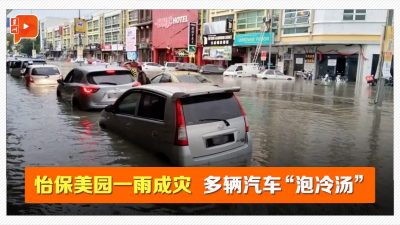Five years ago in 2016, the media reported that Ipoh was elected the cleanest city in Malaysia. Five years later, at the end of 2021, the media reported a totally opposite scenario where there were 1,596 illegal garbage dumpsites, large and small, found in the city and suburbs of Ipoh, some of which stink and disgusting.
Also, it was said that due to the presence of stray dogs, the Ipoh City Council poisoned a pack of them, but did not clean them up, leaving their corpses exposed to the public.
Has the coronavirus outbreak caused the sharp drop in hygienic standards in Ipoh, or are there other reasons?
First of all, we have to ask why there were so many illegal garbage dumpsites which comprised of not only construction waste, but also domestic waste and so on. Obviously, the root cause of the problem should be inseparable from the low administrative capacity and efficiency of municipal waste management.
Why low efficiency in Ipoh?
Solid waste in the city consists of primarily construction waste and domestic waste.
Let’s first talk about construction waste. For all construction and renovation projects, according to Malaysia’s rules and regulations, companies or contractors engaged in are responsible for carrying waste materials to legal sites specified by the government for disposal.
However, there are contractors who do not follow the regulations but choose to locate a nearby open space to privately dispose of the waste under the cover of nightfall.
This misbehavior demonstrates clearly contractors’ lack of awareness of environmental conservation and the negligence of the city council’s law enforcement duties. Besides, the penalty of up to RM2,000 fine for littering offences by the city council often reminds people of the flexibility practiced by its enforcement officers.
Over time, potential offenders would have developed a fluke mindset of chance taking. That means, even if they are caught, it is much more practical to use officers’ flexible way to deal with them.
The overall low efficiency of Malaysia’s city council’s administrative mechanism, in particular the poor waste disposal in Ipoh, can be attributed to two key factors. One is the appointment system of city councilors without open elections.
Since the Umno-led coalition government abolished local government elections in the 1960s, the main officials of the municipal councils have been appointed by the elected state governments. These officials are mainly responsible to their own political parties, not to the city residents. Public unhappiness over their poor performance is in no position whatsoever to influence their status.
The second is the city council’s project management system. In recent years, with the change of management style associated with saving costs and improvement of efficiency, many municipal projects such as garbage disposal have been replaced by outsourcing contract system
In theory, this is a good change, but whether there is a fair and transparent bidding process in calling contracts or a proper supervision over contracting company’s compliance with the terms of the signed contract, is doubtful.
According to an Ipoh resident, she witnessed personally a cleaner blowing all the fallen leaves into the large drain in the back lane of a row of shophouses. This way of doing things was indeed highly efficient because the contracting company did not have to use bags to dispose off the fallen leaves.
As to whether the large drain was blocked and choked by fallen leaves and other garbage, or whether mosquito larvae would breed and multiply, and hence harm the city health, it seemed it was not the concern and responsibility of the contracting company nor the city council.
Kajang and New York examples
There is another incident worthy of discussion that once happened in Kajang, Selangor, where restaurant operators were charged extra for garbage. The Kajang Municipal Council signed a contract with an outsourcing contractor, which stipulated that the contractor was only limited to processing 240 kilograms of waste per day from each shophouse. If there was more, it would not be processed, and the shopkeeper must hire another waste contractor to deal with it.
The question arises as to how you weigh this 240 kg. It’s unlikely that the cleaners would really take out a scale to weigh the garbage!
The adoption of such unrealistic regulations shows that the IQ of the managers of the city council was indeed doubtful! Given the difference in the nature of business of the shops, and consequently the types of garbage arising therefrom, charging different fees by weight of garbage is hardly efficient and practical.

The population of Ipoh had increased from 295,000 in 1980 to 814,000 in 2020, an increase of 2.76 times over a period of 40 years. According to Ipoh Municipal Council estimates, the domestic waste has increased to 500 tons per day, which is equivalent to 0.6 kilogram per capita per day. Such per capita daily solid waste of 0.6 kilogram is indeed very low, but if you add untreated and illegally discarded waste, it should be more than this amount.
Singapore, which is located at the southern end of Peninsular Malaysia, is known to have achieved the world’s advanced level of garbage disposal. The city-state’s severe penalties imposed on people or companies littering are also well-known, and Malaysians are well familiar with them, so I won’t repeat them here.
In contrast, New York, a large consumer city in the United States, produces 2.5 kilograms of domestic waste per capita per day, with up to 12 million tons of waste per year. Overall, New York streets are generally clean and tidy, with well-organized waste management. How does New York do it?
Don’t think that Americans love to talk about freedom and democracy, but they are not as free as Ipoh people in throwing garbage.
As early as 1989, the mayor elected by New York citizens passed the “Waste Sorting and Recycling Law”, which stipulates that recyclable and non-recyclable garbage must be sorted by citizens.
Garbage from shops and restaurants must be placed in a fixed spot in front of the door in the evening, and offenders will be fined. In order to make it easier for citizens to dispose off garbage, the municipal government has placed sorted trash cans at all intersections and residential areas.
Although garbage is waste, New York collects 1.2 million tons of recyclable organic garbage every year, which can be converted into biogas for power generation after treatment.
In addition, New York also has a “return bottle law”, customers can get 5 cents for each can, glass bottle, etc. returned to the shops. Today, 80% of beer bottles and 50% of plastic bottles are recycled.
It is true that there are still many shortcomings in New York City’s garbage disposal, but it provides a good reference for many Malaysian municipal councils in light of their inaction and negligence.
Nevertheless, municipal councils must not be the only actor in managing the city environment, responsibility and cooperation of the citizens and businesses are equally important.
(Wong Tai-Chee has his B.A and M.A degrees in Urban and Regional Planning from the University of Paris, and earned his PhD in Human Geography from the Australian National University. After teaching 20 years in Nanyang Technological University, Singapore, he retired in 2013. He then worked as Distinguished Professor for two years at Guizhou University of Finance and Economics, China, and as Dean and Professor at the Southern University College, Johor until the end of 2018. He was Visiting Professor to University of Paris (Sorbonne IV), Visiting Fellow to Pekin University, Tokyo University and University of Western Australia. His main research interests are in urban and economic issues, and more recently on Malaysian politics. Besides his 15 self-authored and edited book volumes, he has written over 100 academic articles and published widely in international journals.)
ADVERTISEMENT
ADVERTISEMENT








































